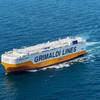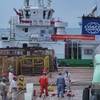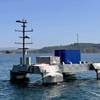Tsakos Energy Navigation 1Q 2009 Profits
Tsakos Energy Navigation Limited (TEN) (NYSE: TNP) reported results (unaudited) for the first quarter ended March 31, 2009. Revenue, net of voyage expenses and commissions, was $106.14 million in the first quarter of 2009 as compared with $115.67 million in the same quarter of 2008. TEN deployed an average of 46 vessels in the first quarter of 2009 versus 43.1 in the 2008 period. The average daily time charter equivalent (TCE) rate was $27,495 versus $31,387 in the first quarter 2008 (TCE is voyage revenue less voyage expenses). Fleet utilization was 98.5% almost unchanged from 98.3% in the first quarter of 2008. Vessel operating expenses per ship per day increased to $9,355 compared with $8,969 in the first quarter of 2008. This resulted principally from increased insurance premiums and higher repair costs, although a strengthening of the US dollar since last year contributed to reduced crewing costs.
Depreciation and dry-docking amortization costs were $24.79 million versus $21.98 million in the first quarter of 2008, reflecting the fleet expansion since the first quarter of last year.
Management fees in the first quarter of 2009 were $3.27 million versus $2.91 million in the same quarter of 2008. This increase was due to fleet expansion and a 3% increase in fees, effective in January 2009.
In the first quarter of 2009, operating income was $38.87 million compared to $86.43 million in the previous year quarter, which also included a capital gain. TEN did not realize any capital gains in the current first quarter compared with $34.57 million in capital gains from the sale of the Aframax Olympia in the first quarter of 2008.
Interest and finance costs were $15.11 million compared to $23.84 million in the first quarter of 2008 due partly to a decrease in interest rates from the prior year quarter and partly to non-cash positive valuations on non-hedging interest rate and bunker swaps amounting to $2.07 million, compared to negative valuations of $6.61 million in the prior year first quarter. Interest income was $1.33 million this quarter versus $2.19 million in the first quarter of 2008.
Net income in the first quarter of 2009 was $24.45 million compared to $65.13 million (which included a capital gain of $34.57 million) in the first quarter of 2008. Diluted earnings per share were $0.66 compared to $1.70 (including the capital gain) in the first quarter of 2007. Cash flow from operations (net income before depreciation, amortization and finance costs, and excluding capital gains) in the first quarter of 2009 amounted to $64.34 million compared to $76.39 million in the first quarter of 2008.
“Net Income in the first quarter of 2009 exceeded our initial expectations in what increasingly became a challenging environment,” observed Mr. D. John Stavropoulos, Tsakos Energy Navigation’s Chairman of the Board. “Nevertheless, as rates softened, TEN’s balanced employment strategy, of fixed charters with some spot market exposure, produced healthy operating results and strengthened further the Company’s financial position.” Mr. Stavropoulos further stated, “This financial strength has allowed the Company to meet all its loan covenants. For the shareholder, TEN was again able, without difficulty, to declare and later pay a substantial dividend.”
The first quarter of 2009 confirmed that TEN’s operating model provides a degree of earnings stability in times of challenging global market conditions. Despite a softening in the tanker market that started in the latter part of 2008, spurred on by a deceleration in world oil demand, TEN’s results in the first quarter of 2009 were encouraging given market conditions. TEN’s vessels again performed at very high utilization levels, 98.5% versus 98.3% in the first quarter of 2008 and voyage revenues were only 7.6% down from the first quarter of 2008, a year which turned out to be a record earnings year for the tanker sector. Most importantly and in line with management’s objective of cash preservation, TEN’s available cash balances increased by 16% to $338 million from the like quarter in 2008.
Prudent cash management, balanced employment and a modern diversified fleet are the three factors moving the Company forward, providing shareholder value irrespective of market conditions. Such value was reflected in TEN’s final dividend for the 2008 operations ($0.85 per share) which raised the total dividend for fiscal 2008 to $1.75.
Another area where TEN modestly utilized its cash during the first quarter was in repurchasing its own stock. With share valuation levels well below management’s estimation of net asset value per share (net asset value being the value of the fleet plus net current assets less debt), the Company continued with its share buyback program. Over the first quarter of 2009, the company invested approximately $3.8 million in acquiring 231,100 shares as treasury stock for an average price of $16.64 per share. Since the initiation of the buyback program in January 2005, TEN has invested over $82.0 million in acquiring 3.8 million shares for an average price of $21.68 per share. Management intends to utilize the remaining capacity of $25.7 million in its buyback program as long as it believes that share levels do not fairly reflect the Company’s true value and as long as there are no other more advantageous uses for the company’s cash resources.
On the chartering front, management remains optimistic that the company’s vessels will continue to be in demand by the chartering community while recognizing that the current downturn in market rates may present difficulties in achieving renewals at previous rates. The charter extension of the suezmax Triathlon earlier in the year, from seven years to ten, at one year increments to a major refiner is only one indication that leading charterers regard our vessels and technical management favorably. Management remains confident that TEN’s vessels will remain on the forefront of charterer’s preferences when looking to secure their worldwide cargo commitments. In addition, the strategic alliances that TEN has established over the years with various international end-users should provide further comfort for the future.
In light of the expected market conditions for the remainder of 2009, management has decided to proceed with a dry-docking realignment schedule to take advantage of the eventual market turnaround when world economies recover, possibly expected as early as 2010 by various market commentators. Of the 11 vessels scheduled to enter dry-dock in 2010, five have been moved forward to 2009. As a result, the company will have more operating days available in 2010 to take advantage of any improvement in the rate environment in that year. Going forward, management expects to maintain TEN’s customary blend of charters to maintain security of employment, downside protection and flexibility to capture rate upturns should they occur. Other than time charters or contracts of affreightment, the company this quarter explored the consolidating opportunities offered by certain pooling arrangements and placed its 1990-built Panamaxes, Hesnes and Victory III into commercial pools without however relinquishing the operational control of the vessels.
For the remaining three quarters of 2009, 66% of the fleet is under secured employment (including vessels under profit sharing arrangements) expected to generate at least $209 million in gross revenues. For 2010, 45% of available days have so far been fixed, which are expected to provide the company with an additional $176 million in minimum gross revenues. Finally, the company notes that its world-class counterparties continue to demonstrate their reliability in a difficult climate as nearly 100% of all trade receivables outstanding as at March 31, 2009 were collected within 40 days since that date.
Looking ahead, TEN will continue its strategy of fleet growth and modernization. The company’s older vessels remain candidates for sale, while attractive acquisition opportunities will be evaluated in conjunction with client needs and market sentiment going forward. During the first quarter of 2009, although a number of opportunities were presented to management for evaluation, the bid-offer spread was too wide to encourage further discussions.
Nevertheless, with banks reducing the availability of credit, opportunities in the secondhand and newbuilding market could present themselves in the course of the year. TEN’s balance sheet enables the company to give serious consideration to such opportunities as it has in the past. The company is also expected to grow organically with the delivery of two newbuildings in the third quarter of this year and its final two newbuildings in the first half of 2010, as planned. These DNA-designed Aframaxes built at the Sumitomo yard in Japan will join the four already delivered to the company and will enhance the attractiveness of TEN’s fleet in the global chartering community. The company has agreed terms for the financing of the first 2009 vessel and is in the process of finalizing terms for the second.
“We entered 2009 with the confidence that the quality, size, employment and strong capital structure of our company will not only withstand any prolonged market downturn, but will also enable us to capitalize on opportunities that might transpire,” stated Mr. Nikolas Tsakos, President & CEO of TEN. “Despite the uncertainty in world markets, which seem to have subsided recently, TEN remains committed to its shareholders in further insulating TEN’s position from market downturns and preserving our solid foundation as the base for further growth in the future. Our fleet’s strong cash flow generation assures the sustainability of our dividend and buyback program without hindering our ability to move quickly to take advantage of attractive opportunities to grow our fleet as we have done in the past,” Mr. Tsakos concluded.











